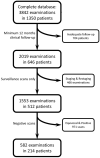Negative predictive value of surveillance PET/CT in head and neck squamous cell cancer
- PMID: 23639557
- PMCID: PMC8051472
- DOI: 10.3174/ajnr.A3494
Negative predictive value of surveillance PET/CT in head and neck squamous cell cancer
Abstract
Background and purpose: Optimizing the utilization of surveillance PET/CT in treated HNSCC is an area of ongoing research. Our aim was to determine the negative predictive value of PET/CT in patients with treated head and neck squamous cell cancer and to determine whether negative PET/CT reduces the need for further imaging surveillance.
Materials and methods: We evaluated patients with treated HNSCC who underwent posttreatment surveillance PET/CT. During routine clinical readouts, scans were categorized as having negative, probably negative, probably malignant, or malignant findings. We followed patients clinically and radiographically for at least 12 months from their last PET/CT (mean, 26 months; median, 28 months; range, 12-89 months) to determine recurrence rates. All suspected recurrences underwent biopsy for confirmation.
Results: Five hundred twelve patients (1553 scans) were included in the study. Two hundred fourteen patients had at least 1 PET/CT with negative findings. Of the 214 patients with a scan with negative findings, 19 (9%) eventually experienced recurrence, resulting in a NPV of 91%. In addition, a subgroup of 114 patients with 2 consecutive PET/CT examinations with negative findings within a 6-month period was identified. Only 2 recurrences were found in this group, giving a NPV of 98%.
Conclusions: In patients treated for HNSCC, a single PET/CT with negative findings carries a NPV of 91%, which is not adequate to defer further radiologic surveillance. Two consecutive PET/CT examinations with negative findings within a 6-month period, however, resulted in a NPV of 98%, which could obviate further radiologic imaging in the absence of clinical signs of recurrence.
Figures
References
-
- Cancer Facts and Figures 2011. American Cancer Society Web site. http://www.cancer.org/acs/groups/content/@epidemiologysurveilance/docume.... Accessed October 28, 2012
-
- Agarwal V, Branstetter B, Johnson J. Indications for PET/CT in the head and neck. Otolaryngol Clin North Am 2008;41:23–49 - PubMed
-
- Branstetter B, Blodgett T, Zimmer L, et al. . Head and neck malignancy: is PET/CT more accurate than PET or CT alone? Radiology 2005;235:580–86 - PubMed
-
- Andrade RS, Heron DE, Degirmenci B, et al. . Post-treatment assessment of response using FDG-PET/CT for patients treated with definitive radiation therapy for head and neck cancers. Int J Radiat Oncol Biol Phys 2006;65:1315–22 - PubMed
-
- Goerres GW, Schmid D, Bandhauer F, et al. . Positron emission tomography in the early follow-up of advanced head and neck cancer. Arch Otolaryngol Head Neck Surg 2004;130:105–09 - PubMed
Publication types
MeSH terms
LinkOut - more resources
Full Text Sources
Other Literature Sources
Medical


